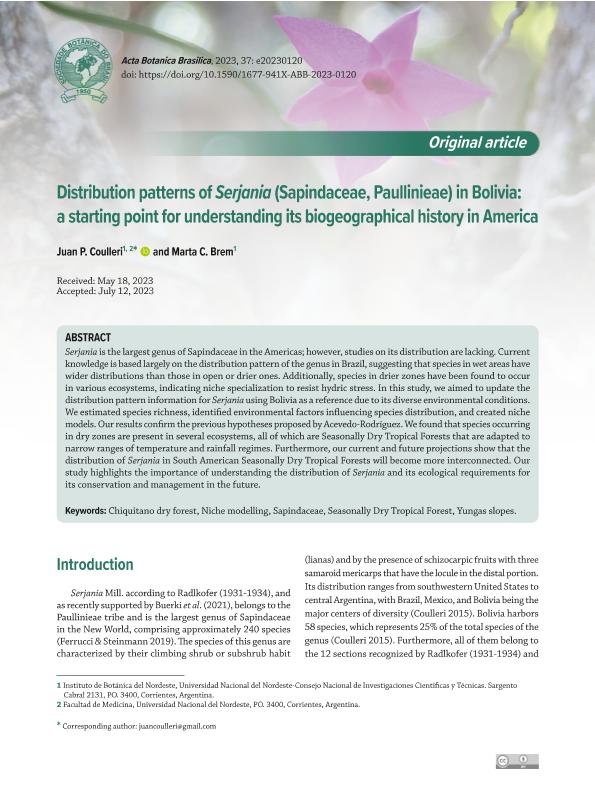Artículo
Distribution patterns of Serjania (Sapindaceae, Paullinieae) in Bolivia: a starting point for understanding its biogeographical history in America
Fecha de publicación:
09/2023
Editorial:
Sociedade Botanica do Brasil
Revista:
Acta Botanica Brasilica
ISSN:
0102-3306
e-ISSN:
1677-941X
Idioma:
Inglés
Tipo de recurso:
Artículo publicado
Clasificación temática:
Resumen
Serjania is the largest genus of Sapindaceae in the Americas; however, studies on its distribution are lacking. Current knowledge is based largely on the distribution pattern of the genus in Brazil, suggesting that species in wet areas have wider distributions than those in open or drier ones. Additionally, species in drier zones have been found to occur in various ecosystems, indicating niche specialization to resist hydric stress. In this study, we aimed to update the distribution pattern information for Serjania using Bolivia as a reference due to its diverse environmental conditions. We estimated species richness, identified environmental factors influencing species distribution, and created niche models. Our results confirm the previous hypotheses proposed by Acevedo-Rodríguez. We found that species occurring in dry zones are present in several ecosystems, all of which are Seasonally Dry Tropical Forests that are adapted to narrow ranges of temperature and rainfall regimes. Furthermore, our current and future projections show that the distribution of Serjania in South American Seasonally Dry Tropical Forests will become more interconnected. Our study highlights the importance of understanding the distribution of Serjania and its ecological requirements for its conservation and management in the future.
Archivos asociados
Licencia
Identificadores
Colecciones
Articulos(IBONE)
Articulos de INST.DE BOTANICA DEL NORDESTE (I)
Articulos de INST.DE BOTANICA DEL NORDESTE (I)
Citación
Coulleri, Juan Pablo; Brem, Marta Carolina; Distribution patterns of Serjania (Sapindaceae, Paullinieae) in Bolivia: a starting point for understanding its biogeographical history in America; Sociedade Botanica do Brasil; Acta Botanica Brasilica; 37; 9-2023; 1-13
Compartir




